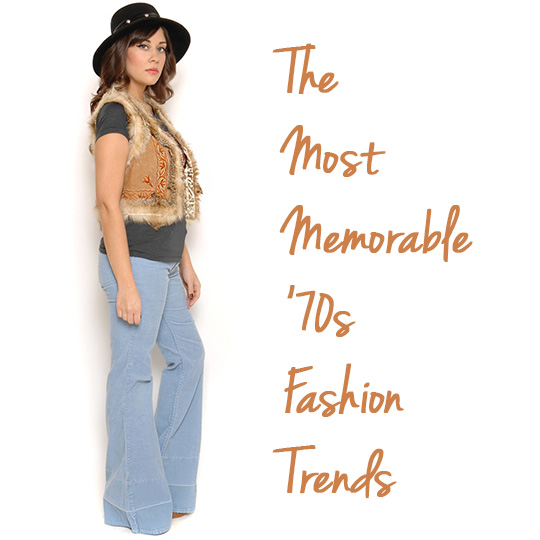
1970s fashion trends represent the rebellion against the old guard that began with the hippie movement of the ’60s.
While designer 1960s fashion focused on the future – like Andre Courrege’s 1964 “Moon Girl” collection that represented American space exploration – the 1970s was a nostalgic era that looked to the past for fashion inspiration.
Most trends of ’70s clothing drew inspiration either from the Edwardian, 1930s or 1940s eras. While the miniskirt was still popular at the onset of the era, the hemline fell to midi and maxi lengths by 1971. The pubescent mod look was out, replaced with glamour that resembled the feminine red carpet styles of ’30s and ’40s starlets.
The laidback lifestyles of the hippie movement inspired the birth of the “leisure suit,” boho style dressing and preference for all-natural materials in the ’70s. However, the all-natural aesthetic was rejected by the nightlife loving disco fiends who wore synthetic materials like polyester and Ultrasuede to shimmy and shake on the dance floor.
The “glam rock” and “punk styles” of the era represented the rebellious style of the 1970s. The LGBT and feminist movements embraced androgyny amongst both sexes. Men wore platforms and dresses to the discotheque. Even the most professional men were encouraged to primp as much as their ladies. Thanks to Yves Saint Laurent’s “anti Dior” look for the long and lean female, suits, trousers and Annie Hall style looks were accepted in the female dress code.
![]()
<< SHOP NOW: Authentic & awesome 1970s vintage clothing!
1950s style and 1960s fashion were eras for the lady. This was the woman whose dress was tailored to fit and accentuate her hourglass shape. She wore matching hats, bags and shoes. Her hair was coiffed and permed, and she never left the house without a red lip and rouged cheeks.
The 1970s woman defined style her own way. She wore the most wild looks and makeup by night but by day, she could be dressed like a man or perhaps, channeling the peace-love-mentality of the late ’60s in a ditzy print floral maxi dress or decorative pair of denim bell bottoms.
1970s fashion rejected formality in favor of function. This trend for “casual dressing” is what arguably laid the foundation for 1980s, 1990s and 2000s dressing. The return to everyday formal wear, except in the work place or at high profile events, has yet to return. We have the 1970s to thank for chic, classic comfort that’s versatile for the working girl on the go.
Most importantly, being an extension of ’60s hippie fashion, the 1970s birthed freedom of self expression. According to ’70s fashion expert Anne-Lise Francois, “in the 1970s, people wore clothes that stood out in order to fit in.”
Styles were bold, colorful and free. Gender roles were challenged, fashion expectations broken and an affection for wearing bonafide vintage fashion or vintage-inspired styles began.
What do you love most about 1970s fashion trends? Whether you’re a fan or a vintage shop owner looking to spread some ’70s love, let me know your thoughts in the comments below!
Share your thoughts in the comments below the post, or by saying hello on Twitter, Facebook, Instagram or by subscribing to my newsletter!
xx, SD
’70s Fashion Trends
Feel free to scroll through the post to learn how these ’70s fashion trends stand out in history, or click any of the links below to be taken immediately to the text within the article!
#1: Mini Skirts
#2: Maxi & Midi Skirts
#3: Disco Style
#4: Wrap Dresses
#5: Leisure Suits
#6: Ultrasuede
#7: Decorative Denim
#8: Natural Boho Look
#9: Edwardian Style
#10: High-Waisted Pants
#11: Punk Style
#12: Leotards
#13: Jumpsuits
#1: Miniskirts – ’70s Fashion Trend
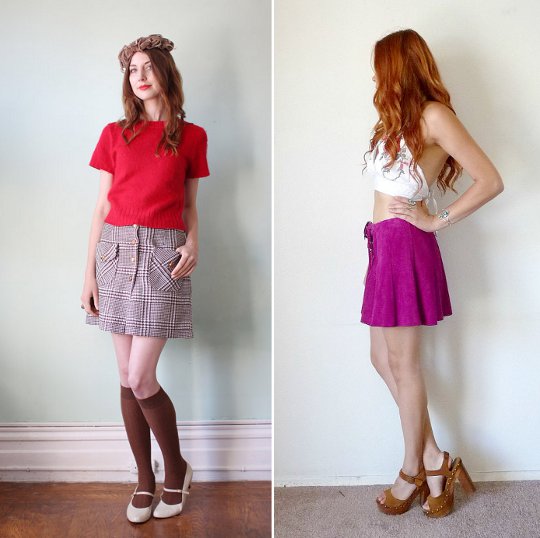
’70s Plaid Brown Wool Miniskirt / ’70s Purple Suede Lace-Up Miniskirt
The miniskirt, made popular thanks to designer Mary Quant in 1964 in London, was still in full rage at the beginning of the decade.
All women were wearing it then, rather than the ’60s Pretty Young Things who readily adopted it as a form of fashion rebellion when first introduced.
From mature (plaid) minis to the eye-catching brights of dyed suede or patchwork styles, there was a marvelous mini for every woman by 1970.
#2: Midi & Maxi Lengths – ’70s Fashion Trend
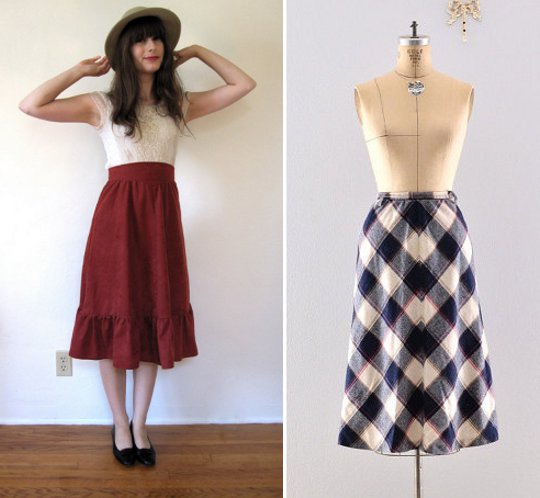
’70s Rust Red Midi Skirt / ’70s Blue, Red & White Plaid Midi Skirt
In 1970, fashion industry magazine Women’s Wear Daily declared it “The Year of the Midi.” Influences from the Victorian and ’30s eras inspired designers to drop the hemline back to a longer, more romantic state-of-length.
However, the miniskirt had become so popular that there were protests against the midi! According to The Vintage Ramble: “A protest signed by 335 customers of the Sanger-Harris store in Dallas reads: “We object strongly to being suppressed into buying the midi exclusively. We like looking feminine and intend staying that way, even if it means shopping elsewhere.”
The rebellion didn’t last for long. Fashion companies began producing their styles in mini, midi and maxi lengths to satisfy every woman’s hem-length desire.
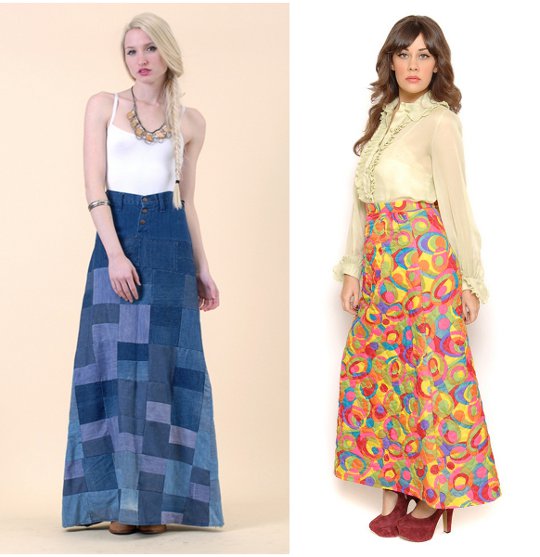
’70s Denim Patchwork Maxi Skirt / ’70s Quilted Psychedelic Maxi Skirt
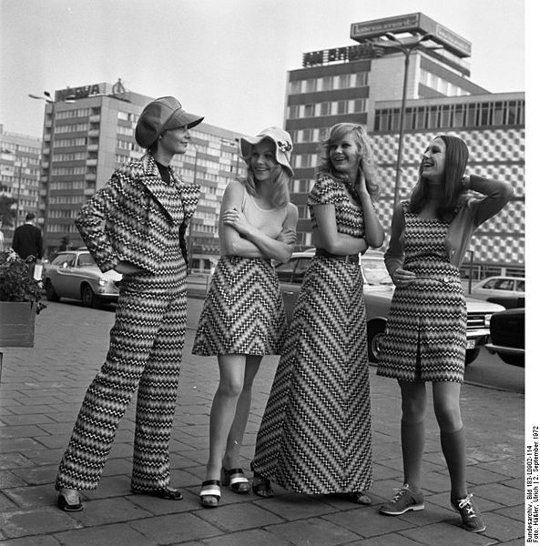
Source: Wikipedia
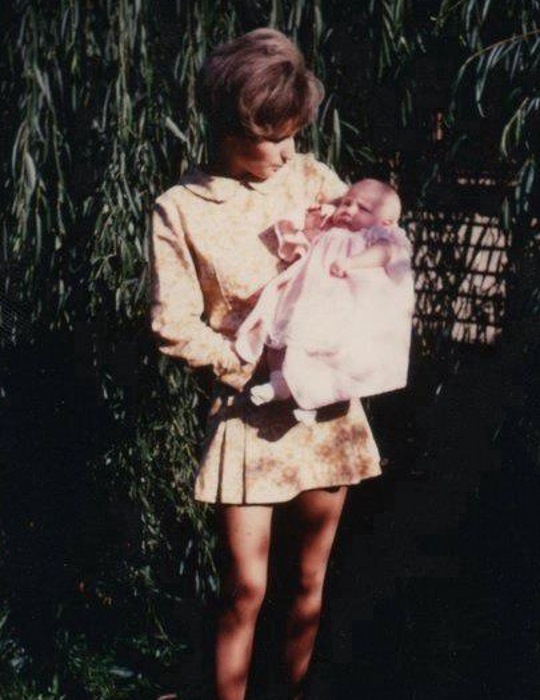
Source: Tracey from South Australia! Visit her at Salvage Design Studio
From Tracey: This is of my mom holding me in 1971, looking amazing in a mini just 9 weeks after I was born. She passed away at the age of 38 from cancer and we lost our dear dad in October last year.
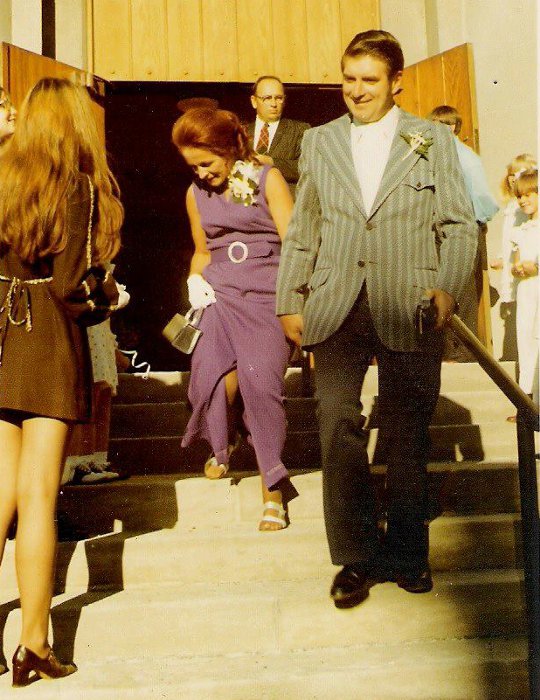
Source: Fawn from Cherry Dolly Face
From Fawn: This picture is from 1973. My handsome Poppie in the dapper suit, who passed away a couple years ago. My sweet Grandma in the purple dress. My beautiful Aunt in the brown dolly dress, who passed away in 1976 at the age of 23 when a drunk driver crashed into the car she was riding in. I love my family : )
#3: Disco Influences – ’70s Fashion Trend
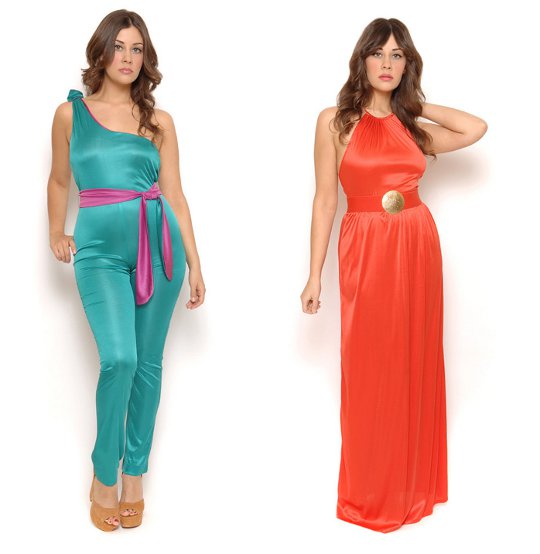
’70s Teal Tapered Leg Jumpsuit / ’70s Bright Orange Goddess Maxi Dress
The first article written about disco music was published in Rolling Stone magazine in 1973, and soon after a disco-only music station debuted on New York radio.
The disco era was born and with it, a night scene reserved for liberal self-expression, glamour and fantasy. According to Diana Monkowski of The Ultimate History Project, “Discos are nothing if not a fantasy world, where you can change your identity by changing your costume.”
And change their costumes women certainly did! The party dresses of the ’50s and ’60s took a backseat when dancing the “Hustle” became a trend. Off the shoulder body-grazing jumpsuits, flowing knee-length “Grecian” style dresses and hotpants were conventional disco styles in the ’70s.
If the fashion was flashy, it was perfect for the discotheque. Shimmery polyester fabrics like gold lame were worn accentuated with sky-high platforms and sparkling jewelry that reflected the glimmer of the disco ball above. These attention-grabbing styles helped a girl to stand out on the dance floor and attract an interested dance partner.
The adoption of spandex (invented in 1959) during the ’70s created comfortably-fitting body-skimming jumpsuits and dresses that fit any size or waistline. Lycra was another popular material used. Both materials helped disco dancers to move and groove without restriction.
The tight, sexually-inspired clothing of the ‘70s disco era represented women’s desires to express their sexuality through their clothing. The feminist movement, while not unified in this belief, inspired women to embrace exhibitionism of their bodies as a way to declare sexual freedom, strength and control.
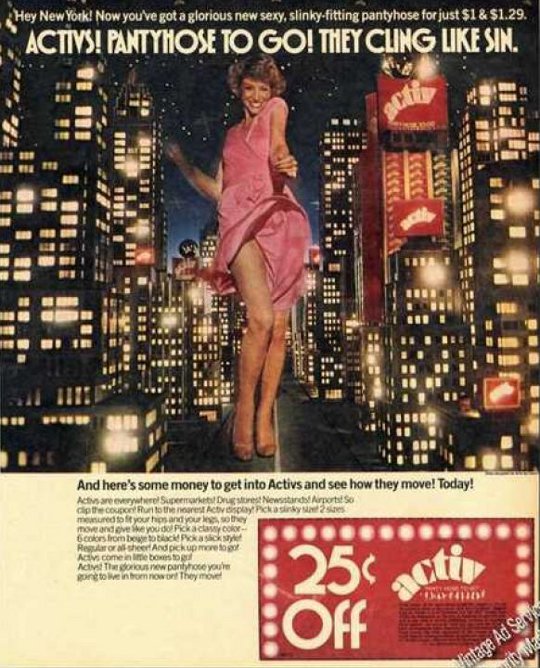
Source: Vintage Ad Browser
#4: The Wrap Dress – ’70s Fashion Trend
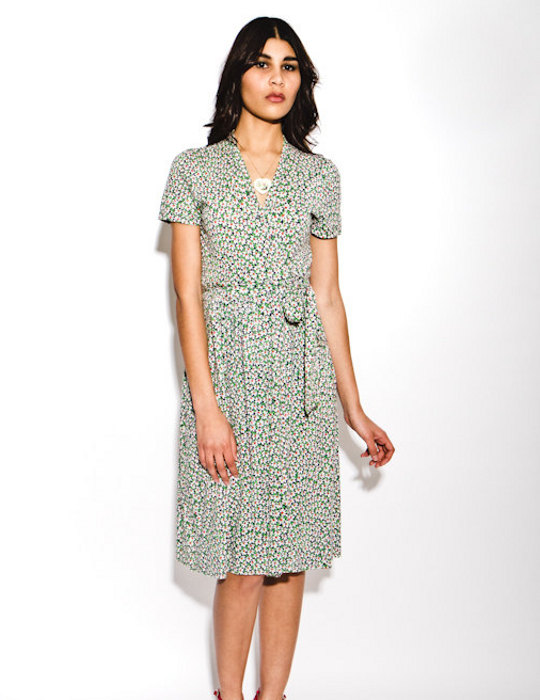
’70s Diane von Furstenberg Wrap Dress
Designer Diane Von Furstenberg invented the jersey knit wrap dress in 1972. By 1976, the fresh style had become mainstream, selling nearly 5 million versions of the now iconic style. She told New York Magazine in 1988, “I would see 20, 30 dresses walking down one block. All sorts of different women. It felt very good. Young and old, and fat and thin, and poor and rich.”
Belgium-born Diane married Italian Prince Egon von Furstenberg in 1969, divorcing three and a half years later in 1972. She began working in the New York fashion industry in 1970, having said to press in past interviews: “The minute I knew I was about to be Egon’s wife, I decided to have a career. I wanted to be someone of my own, and not just a plain little girl who got married beyond her desserts.”
The wrap dress was inspired by seeing former President Nixon’s daughter Julie Nixon Eisenhower wearing a wrap blouse with a wrap skirt. Diane used this image as her motivation to combine the two into one “wrap” piece.
The wrap dress was different from anything that had appeared in fashion before, fusing the casual “housewife” cotton frocks of the past eras (most notably the ’40s-’60s) with the modern appeal of a dress that could be worn from morning to night without the hassle of getting “dressed-up.” The style became a symbol for female empowerment because they were so easy to wear, practical and functional for women of all body types and backgrounds.
Her ad campaign said “Feel like a woman — wear a dress!” which is amusing considering this style was the most relaxed “dress” to appear on the market … ever. DVF sold as many as 25,000 dresses a week once she exploded on the scene.
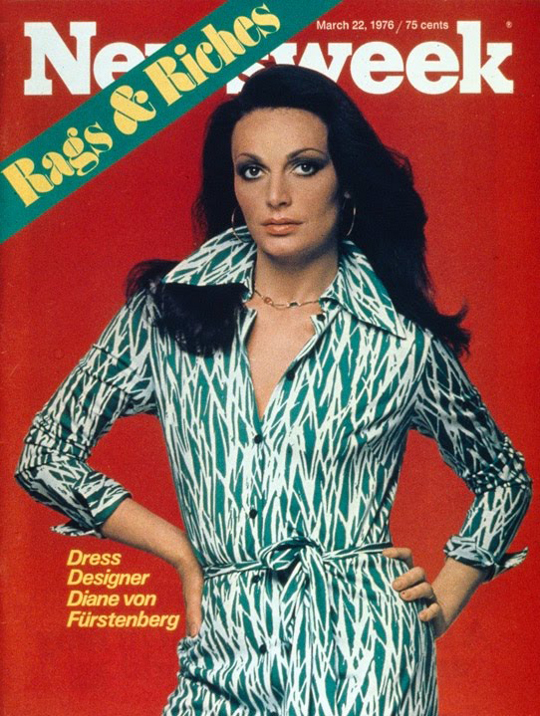
Source: Newsweek Magazine Cover / Styleite
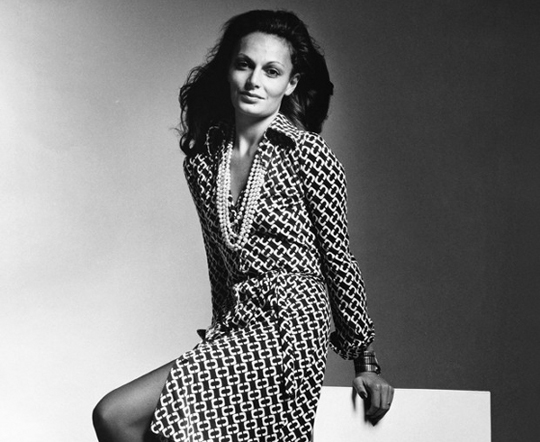
Source: Diane von Furstenberg Ad / Peggy Oberlin Interiors
#5: Leisure Suits for Women – ’70s Fashion Trend
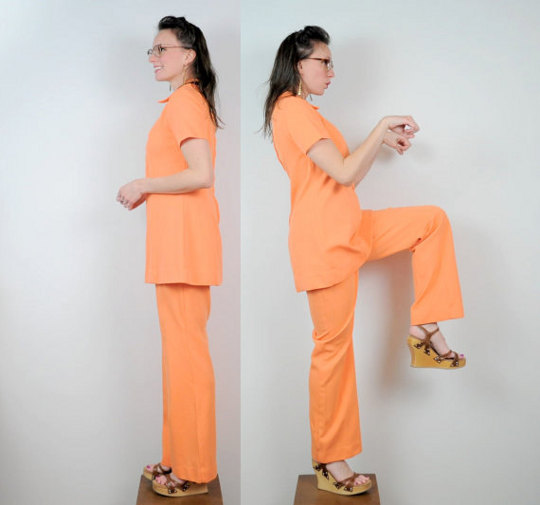
The ’70s leisure suit was a style popular for men that influenced women’s fashion as well. It was introduced to the fashion world in 1975 by Lee Jeans (their name for it was “LEE-sure”) as a casual suit for business attire.
It was first designed by Jerry Rosenbgarten in 1970, who took inspiration from the non-conventional styles of the ’60s fashion hippie generation to produce this ethos of laidback dressing for the more business-inclined professional ’70s male. It never quite made it the boardroom though, rather adopted on the disco dance floors as classic male uniform for doing the boogie-woogie.
The style’s popularity lasted only a few years until it was replaced by the power suit of the ’80s, but is remembered as being one of the most representative (and amusing) trends of the 1970s that represented the era’s hatred for formality.
A man’s leisure suit was more “leisurely” for the following reasons. The material was often synthetic (like polyester) and could be easily thrown into the wash (versus dry cleaning) after wearing. Jackets were button-up “shirt styles” and worn without ties. Because the suits were made from synthetic materials, they were also much lighter and could stretch with the body.
Pants were lower than the typical suit for further comfort and the jacket collar, lapels and chest pockets were oversized to make up for the lack of tie.
The best part about the leisure suit were the colors! Pastels, plaids and geometric designs were the preferred designs. Men didn’t shy away from wearing Easter lilac, creamsicle orange and wedding whites. Shiny, equally loud patterned shirts were worn with leisure suits. Let’s just say the potential for clashing was high!
The men’s leisure suit inspired a similar style among women. Women wore brightly colored matching pants and jackets or long tunic tops made from synthetic materials. The styles were particularly amusing to see when a husband-wife or boyfriend-girlfriend couple wore their leisure suits together!
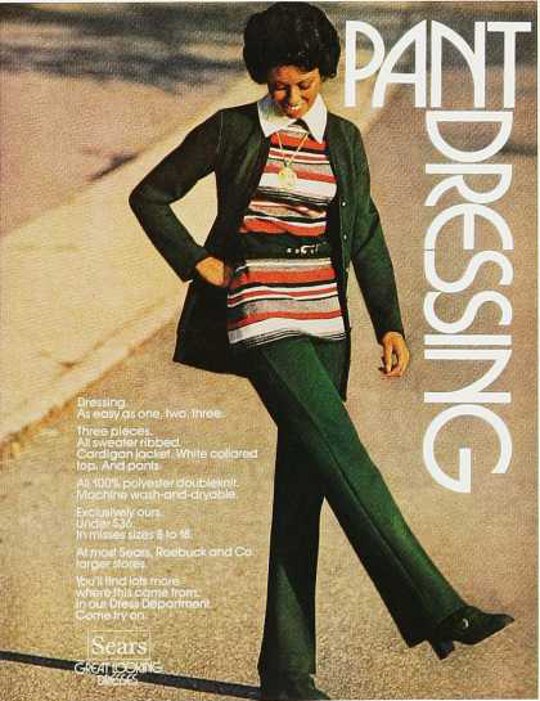
Source: Vintage Ad Browser
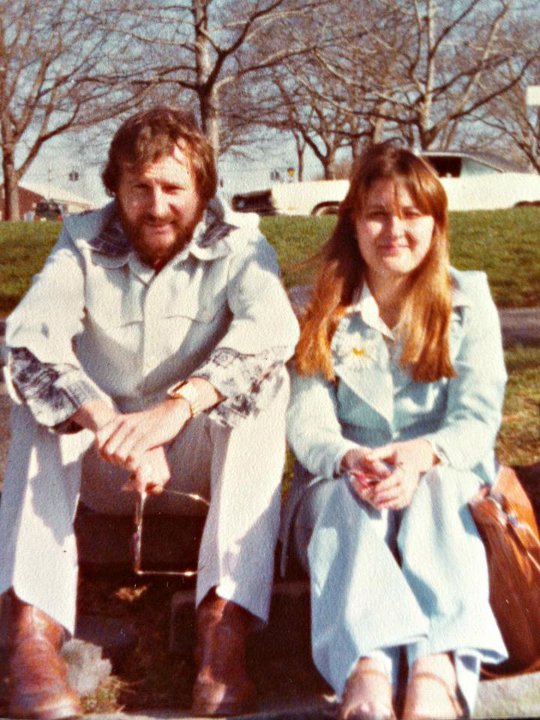
Source: Red Hanger Vintage
Her Mom & Dad wearing leisure suits in the ’70s!
#6: Ultrasuede – ’70s Fashion Trend
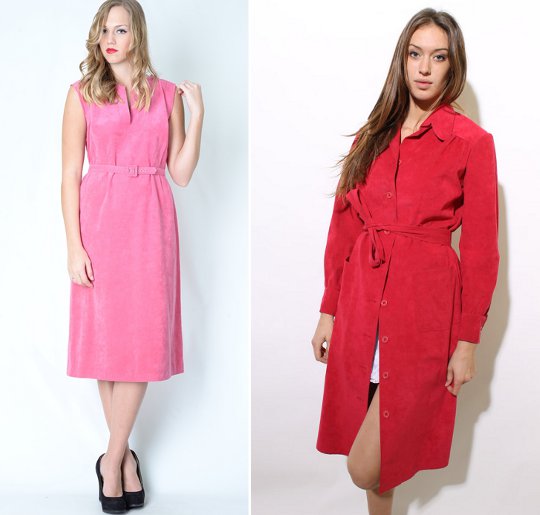
’70s Ultrasuede Pink Dress / ’70s Ultrasuede Red Coat
Not just suede … this is ultrasuede!
According to the Vintage Fashion Guild, Ultrasuede is “a trademarked fabric dating from 1970, Ultrasuede is a nonwoven fabric resembling suede. It is made of polyester, non-fibrous urethane and synthetic resins. It is created in a process involving needle punching microfibers into a felt-like ground.”
So there you have it: Ultrasuede is actually just a swanky name for a polyester blend that according to Wikipedia, was invented in 1970 by scientist Dr. Toyohiko Hikota of Toray. It was the first “microfiber” blend of its time and like other synthetic materials in the ’70s, it became all the rage and especially so when designer Halston adopted it as a favored fabric for his collections.
The material was used to make skirts, dresses and jackets and rather than as an accent piece, the entire garment was made from Ultrasuede. While the material was soft and looked “new” even after washing, don’t be fooled by the tricky technology. The polyester dress is the cousin to the Ultrasuede garment and considering both are man made and mass produced, considered cheap materials in comparison to other styles on the vintage market.
Ultrasuede is still used today on just about anything, from clothing to interior decorating and car upholstery or as a protective covering for electronic equipment.
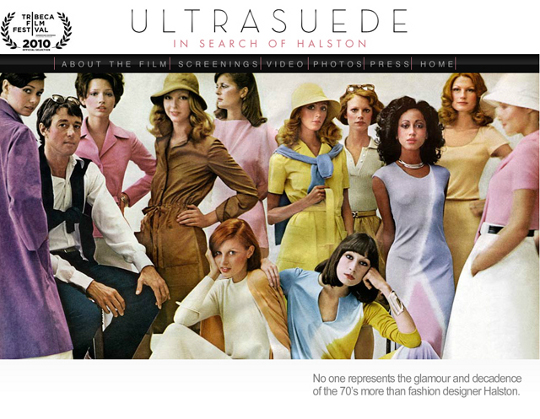 Source: Ultrasuede: In Search of Halston
Source: Ultrasuede: In Search of Halston
In 2010, a documentary called “Ultrasuede” about legendary ’70s designer Halston had fame at the Tribeca Film Festival. He was one of the leading pioneers of the fabric and memorable names of glamorous ’70s disco fashion.
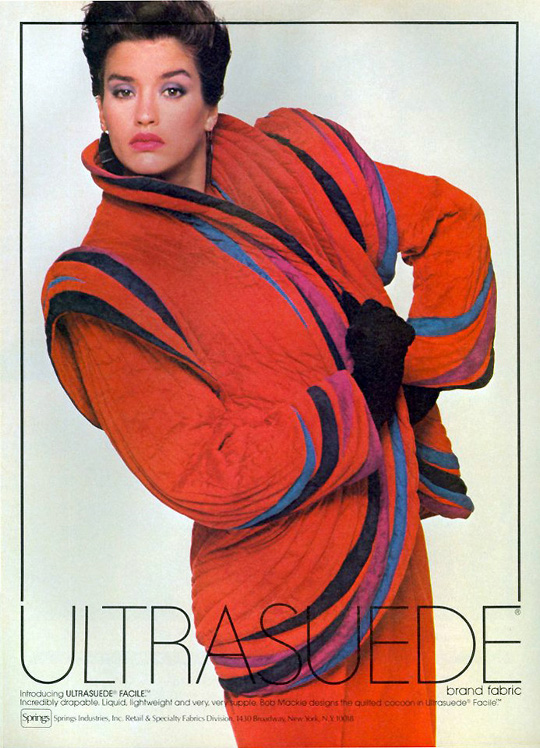
Source: Vintage Ad Browser
#7: Decorative Denim – ’70s Fashion Trend
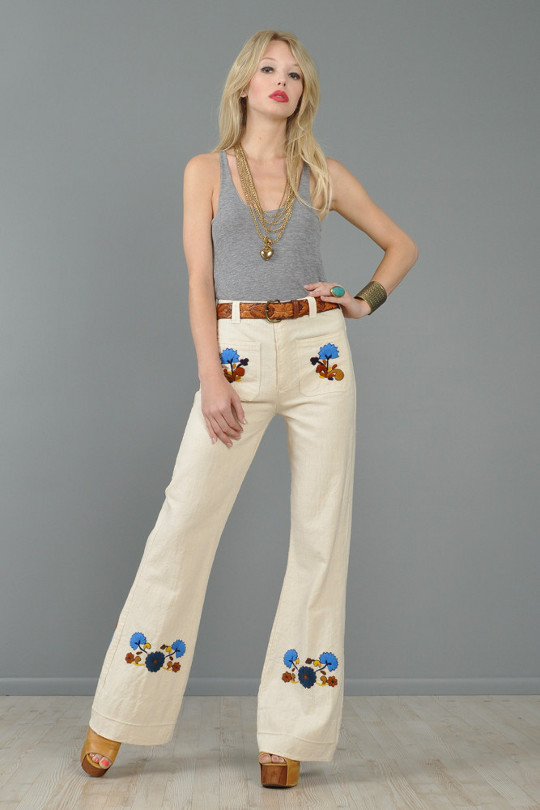
’70s Floral Embroidered White Bellbottoms
Denim was nothing new to the ’70s. The fad for denim began in the ’50s when pop stars like Elvis Presley and movie stars like James Dean began sporting them on stage and in films, influencing their teenager fans to want a pair of their own. Before the ’50s, denim was associated with workwear only.
The movement for denim continued in the ’60s with the counterculture hippie movement and by the ’70s, was a mainstream garment that every man and woman had in their wardrobe. You couldn’t not go to a concert without wearing a pair of denim bell bottoms! In 1971, Levis won a prestigious Coty Fashion award for its influence with denim, thereby establishing denim within the world of “high-fashion” acceptance.
The difference between ’50s-’60s denim and that of the ’70s was that denim became high-fashion attire, decorated with natural, earth-inspired embroidery, multi-colored stitching and other eye-catching embellishments. Over-the-top color was characteristic of ’70s style, so it comes as no surprise that denim couldn’t just simply be “blue” for some of its wearers.
Denim in the ’70s was marketed for its “fit” function. ’70s denim ads say that their pair is “the best fitting” or the “most sexy,” depicting a man holding a woman’s tush in a pair of jeans. The idea that denim as a flattering option of casual-wear was as prominent in the ’70s as we see in marketing today.
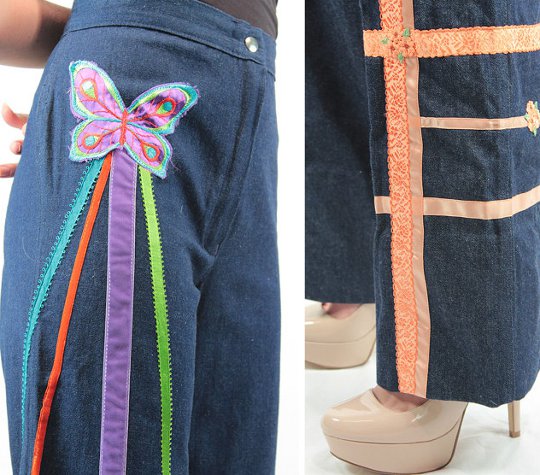
’70s Embroidered Butterfly Denim / ’70s Embroidered Peach Ribbon Denim
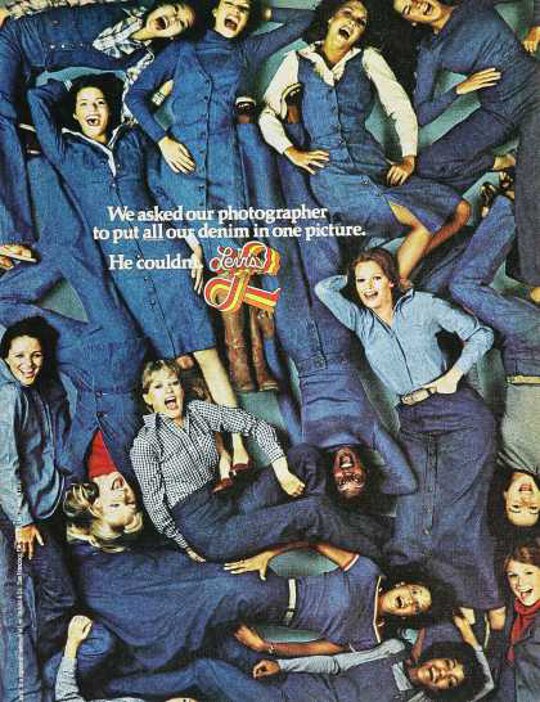
Source: Vintage Ad Browser
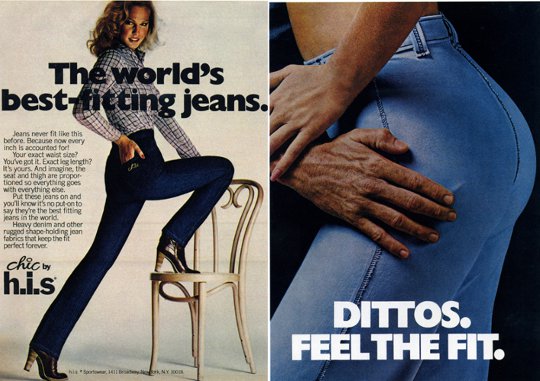
Source: Denimology
#8: The Natural Boho Look – ’70s Fashion Trend
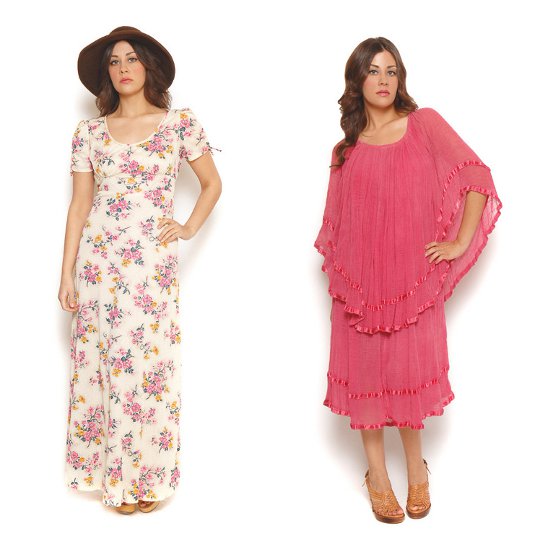
’70s Boho Floral Maxi Dress / ’70s Gauzy Cotton Boho Dress
The 1970s took the counterculture of the 1960s and made it mainstream. This is why so much of the styling you see with 1970s clothing resembles the hippie movement of the ’60s.
Essentially, the casual, laidback “super casual” vibes of the happy hippies were adopted by the professional yuppies of the ’70s. Formality was rejected in favor of easy breezy styles by day and for the flashy, fashion-forward types, the decadent disco styles for night.
Still, the disco era birthed a unique rejection of its own. Because synthetics were accepted as the material du jour, a movement for natural fibers and natural fashion emerged. Wooden heels, fur fringe vests and gauzy cotton dresses became earth-friendly attire. Hand-knitting sweaters, making macrame bags and crocheting dresses and tops became popular past times and “natural fashion” crafts.
Earth tones (browns, beiges, light purples, dark greens) were used as the colorway for one piece, often in patchwork prints that felt homespun and handmade. Small, delicate florals were preferred over larger florals, as inspired by the ditzy prints of feedsack dresses in 1930s fashion. The Eastern influences of ethnic attire popularized kimonos, caftans and “hosting gowns” that resembled styles from Morocco, India and Asian countries.
Sewing your own clothes was still protocol for many women. Sewing patterns embraced the ’30s relaxed looks as inspiration: Long, flowing dresses with empire waists that covered the entire body. A woman’s body was a canvas for ethereal glam that was romantic and relaxed, versus the fitted, silhouette defining styles of the ’50s and ’60s fashion.
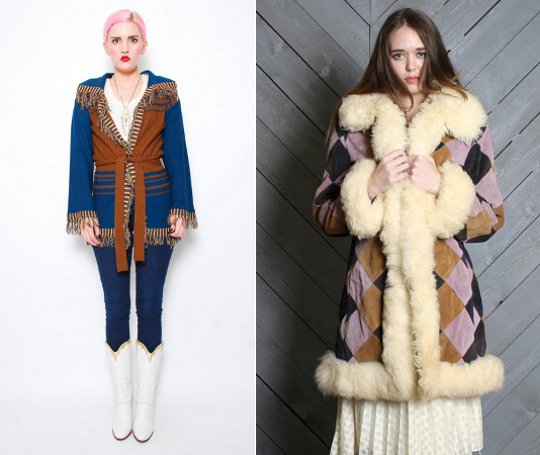
’70s Boho Knit Wrap Sweater / ’70s Penny Lane Harlequin Coat
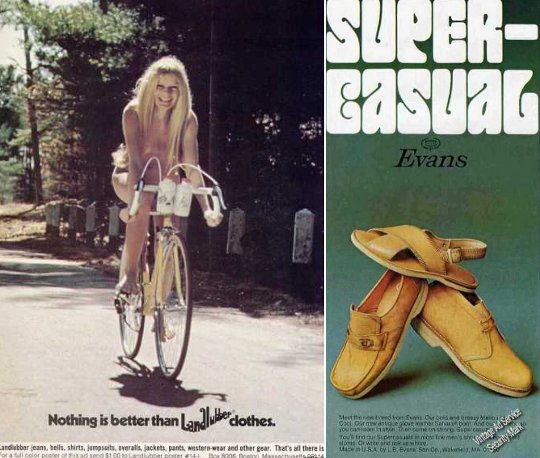
Source: Vintage Ad Browser
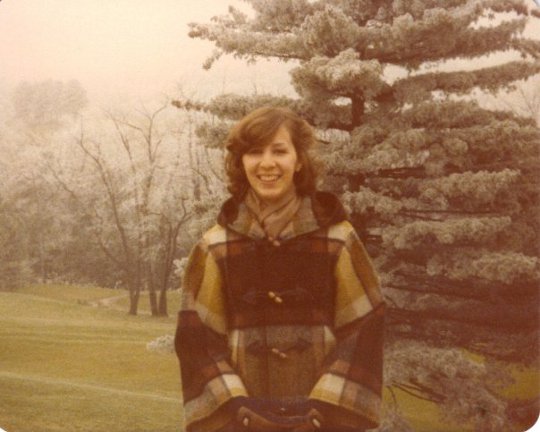
Source: Ann from Dodeka Vintage
From Ann: My mom was so stylish! I especially love that coat. She regrets ever getting rid of it… and so do I!
#9: Edwardian Style Dresses – ’70s Fashion Trend
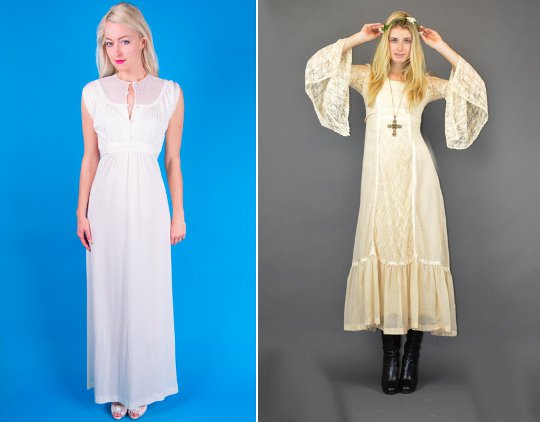
’70s Edwardian Style White Maxi / ’70s Edwardian Style Angel Sleeve Cream Dress
The Edwardian era was lace, layers, length and when worn the right way … downright lust! This is why 1970s designers took such inspiration from the Edwardian period for their feminine, floor-length frocks.
Button-up necks, illusion necklines and butterfly or angel sleeves on dresses cut either without a waist or a higher-fitting empire waist were quintessential elements of Edwardian ’70s style. Sometimes prairie elements were added, like ruffled tiers or corset ties, as popularized by designer Gunne Sax.
The Edwardian-inspired ’70s styles were so popular that even a brand called “Young Edwardian” was born. It was like a vintage style reproduction company today, except it took turn-of-the-century influences to create modern 1970s pieces.
According to the Vintage Fashion Guild, the Edwardian trend descended from Great Britain. The stalls of famous London markets like Portobello and Camden Market were filled with (then) vintage Edwardian clothing.
British ’70s designers like Ossie Clark were inspired by the styles they found and rockstars like Mick Jagger were known to sport authentic Edwardian attire for photo shoots and on stage.
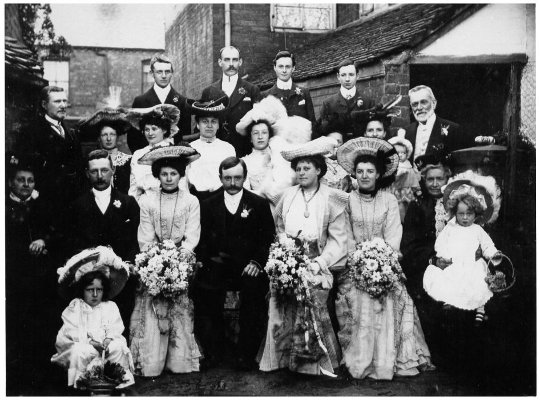
Source: Edwardian Family Photo / Fashion-Era
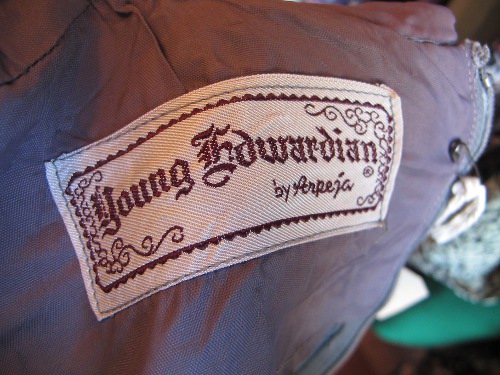
Young Edwardian vintage clothing label.
#10: High-Waisted Pants – ’70s Fashion Trend
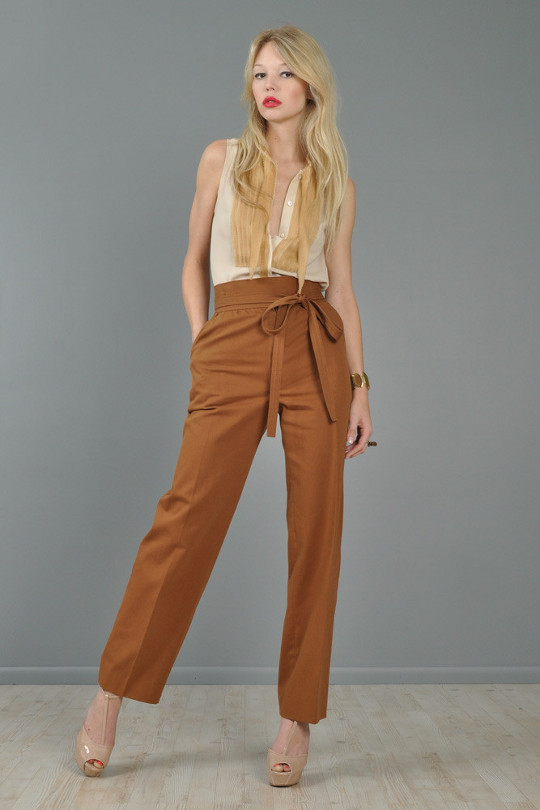
’70s YSL High-Waisted Ankle Pants
Gender roles were being challenged in the ’70s, thanks to feminism, fashion and the explosion of the LGBT rights movement. As simple as it may seem, the “trouser” pant represents more than just a flattering fit.
Yves Saint Laurent can be thanked for popularizing the trouser pant for women. High-waisted pants, as inspired by the similar styles of the 1940s, were part of Laurent’s collections in the ’70s.
Much like Christian Dior did with his Corelle “New Look” line in 1947 (which emphasized a woman’s hourglass shape and itty bitty waist), YSL shook up the fashion world when he designed clothes for the androgynous shape of a long, lean woman. In a way, his masculine tailoring was the “anti Dior” of the 1970s.
When Laurent debuted his Le Smoking Jacket in 1967, it set the stage for an era that favored masculine tailoring and feminine strength. No more were dainty lips, 24-inch waists and petite figures of the “giddy feminine.”
YSL made clothing that was tailored to “lean” out a woman’s figure away from possessing curves. It became his design voice and his ’70s androgynous collections are arguably the precursors to the ’80s “power suit.”
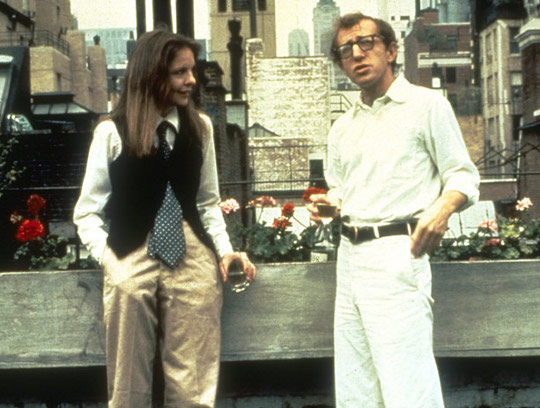
Source: Annie Hall Still / MGM Studios
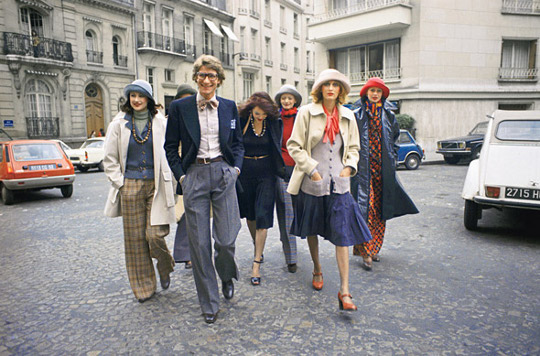
Source: YSL with Models / Gamine
#11: Punk Style – ’70s Fashion Trend
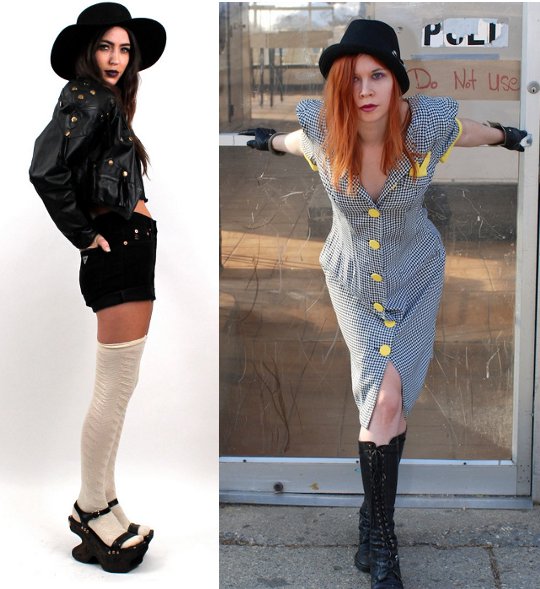
’70s Punk Leather Jacket / ’70s Punk Lolita Style Dress
The punk style trend of the ’70s was first born in London. Great Britain was suffering hard financial times, and so the youth of the country rebelled against the government with a very DIY, anti-establishment look. It was intended to be aggressive and frightening, as to demonstrate that these “punks” were totally independent and without need of control or guidance from anyone.
Designers Vivienne Westwood and Zandra Rhodes are remembered best as punk-influenced designers of the ’70s, and Betsey Johnson of the ’80s followed in her footsteps. The 1980s punk look was distinctly different from the ’70s one and because of the unique influences between the US and UK.
But the punk music movement was equally as influential on the fashion scene and for women, punk style was another chapter in androgynous-wear that was meant to shock and confuse the admirer. Women combined masculine and feminine elements in their look, such was wearing a sweet Lolita style dress with vintage lace up combat boots originally worn by a soldier in World War II.
The variations of the “punk” look are plentiful, mostly because this personal style became something uniquely defined by its wearer. However, the intent was to shock, confuse and even frighten anyone who witnessed the look firsthand. Style value became shock value with ’70s punk fashions.
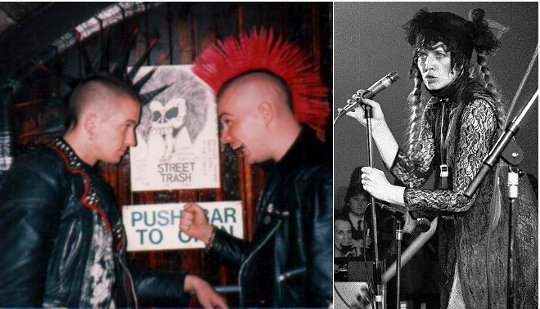
Source: Two Punks (left) and Punk Rocker Lene Lovitch / Wikipedia Commons
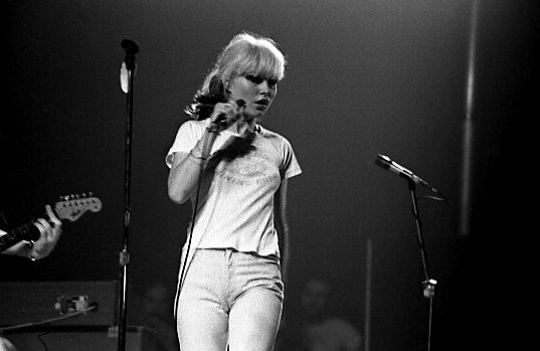
Source: Debbie Harry of Blondie on Stage / Wikipedia Commons
#12: Leotards – ’70s Fashion Trend
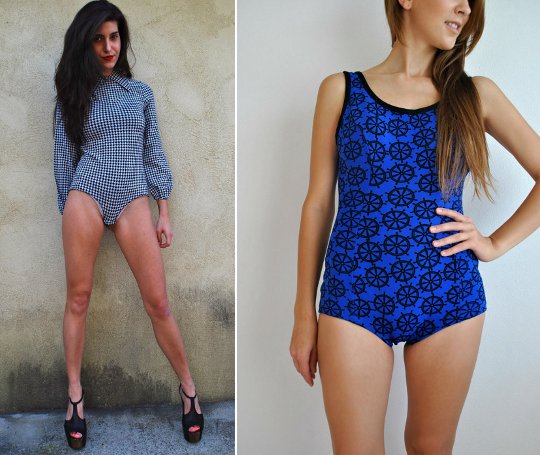
’70s Long Sleeve Leotard / ’70s Blue Nautical Style Leotard
The 1970s was the birth of the athletic body. For the first time, women were actually encouraged to exercise! The sports industry for women was born and with it, styles that were intended to be worn for high performance activity.
Danskin was the leading dancewear company in the ’70s, producing leotards for its dancers, ice skaters and gymnast customers. But with sports and hyper-sexualized disco fashion trend, some women began favoring tightly-fitting clothes with more sporty qualities.
Danskin took note of this trend and in their advertising campaigns, began stating that “Danskins are not just for dancing.” Thus, the trend of wearing leotards as “bodysuits” began. Women wore them with pants and skirts, usually with a jacket/blazer on top if the they were more conservative and the leotard was cut tight and made from spandex materials.
Some leotards weren’t made from spandex and actually had long sleeves or even a collared neck. These were less workout-inclined styles that could be worn as leotard “shirts” since they were “tucked in” without having to physically do so.
Many of these leotards had the classic “snap crotch” that has become amusingly famous in the vintage fashion world. The snaps made it easy for a lady to use the restroom, without having to take the entire leotard off and over her head!
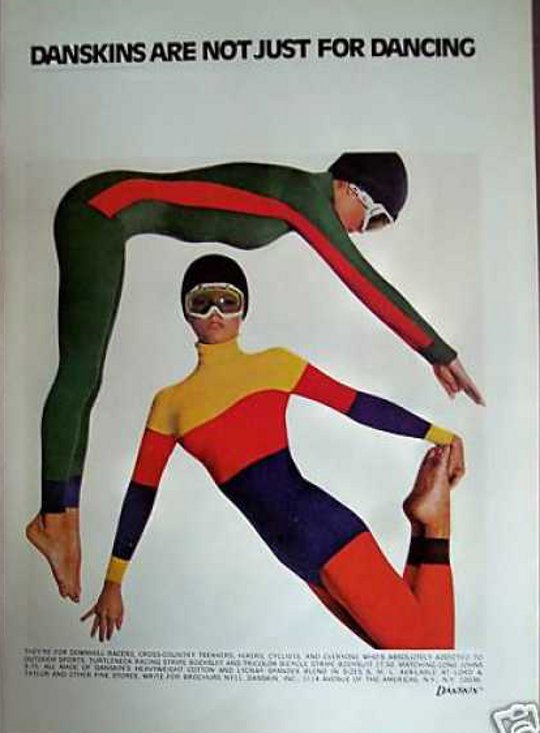
Source: Vintage Ad Browser
#13: Jumpsuits – ’70s Fashion Trend
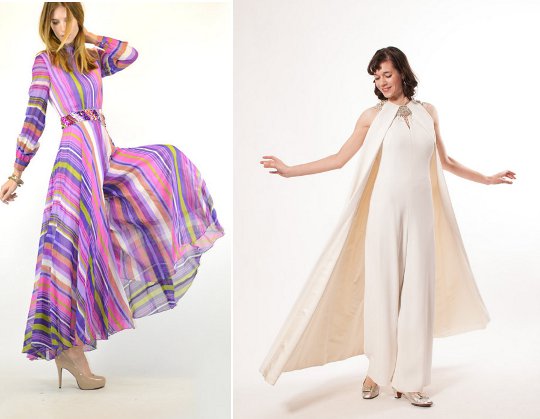
’70s Sheer Chiffon Palazzo Jumpsuit / ’70s Cream Caped Designer Jumpsuit
We all remember Elvis Presley donning his iconic jumpsuits throughout the ’70s. The style was popular for both sexes during the era, both worn leisurely and on the disco dance floor.
The jumpsuit was not born in the ’70s but actually in Great Britain during the ’40s World War II years. Women kept them nearby in the event air raid alarms went off and they needed to throw something functional on in the middle of the night and “jump” into a protective bomb shelter. The style’s name is even more appropriate considering it was also worn by parachuters when jumping out of a plane.
The jumpsuit in the ’70s became a fashion staple for a few reasons. The style had already entered the fashion consciousness in the late ’60s as “hosting” wear, or styles that a woman would wear when she was hosting guests at her home and in need of something a bit more “comfortable” to properly perform her duties. The jumpsuit was also worn as “lounge wear” for when a women was simply relaxing around the home – almost like today’s robe and slippers combo.
The jumpsuit took on a more glam style in the ’70s. Made from chiffon and often in bright colors and with graceful palazzo pants and attached capes, the jumpsuit was an alternative style to the maxi dress that when worn with platform heels, would make for a killer ensemble and entrance to any party then or now.
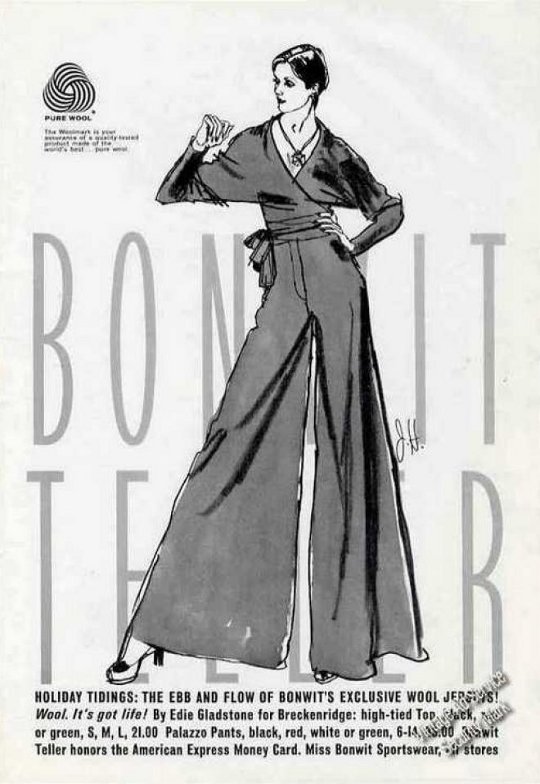
Source: Vintage Ad Browser
Your ’70s Vintage Photos
Thank you to everyone for submitting their 1970s family photos for inclusion in this post! I’m so blessed to be in the position to share these keepsake memories with the world. I honor and respect your family’s legacy and am thrilled that you feel comfortable sharing a bit of their stylish past with me!
If you would like to see your vintage family photos published in an upcoming post here, please email them to me ([email protected]) or share them on the Sammy Davis Vintage Facebook page.
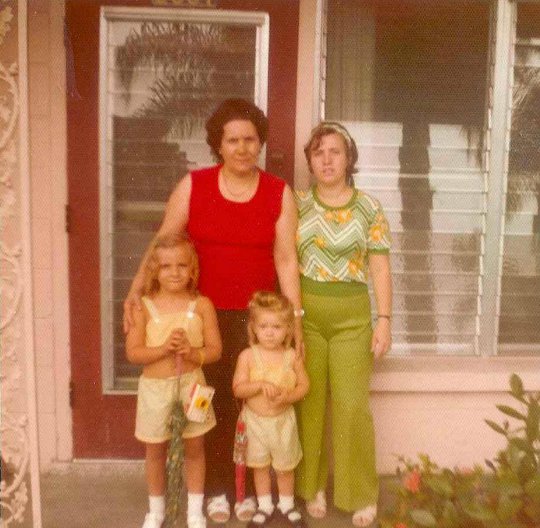
Thanks to to Recultivation Vintage.
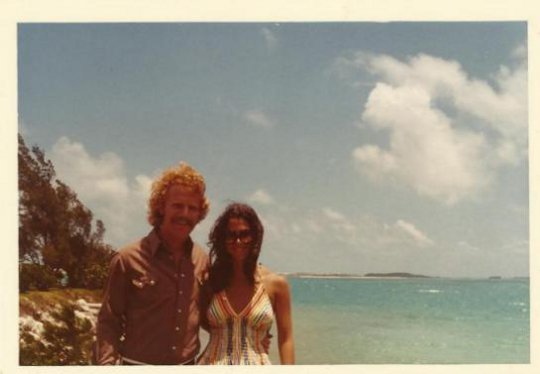
Thanks to Little Bird Vintage.
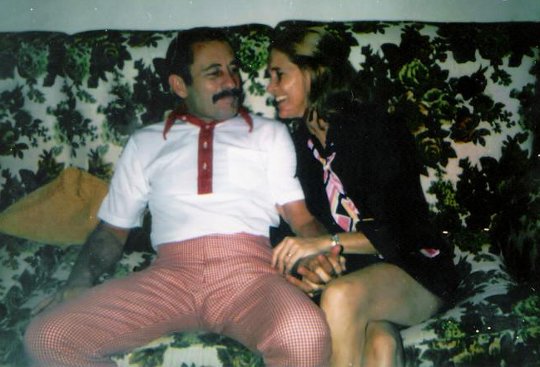
Thanks to Laura.
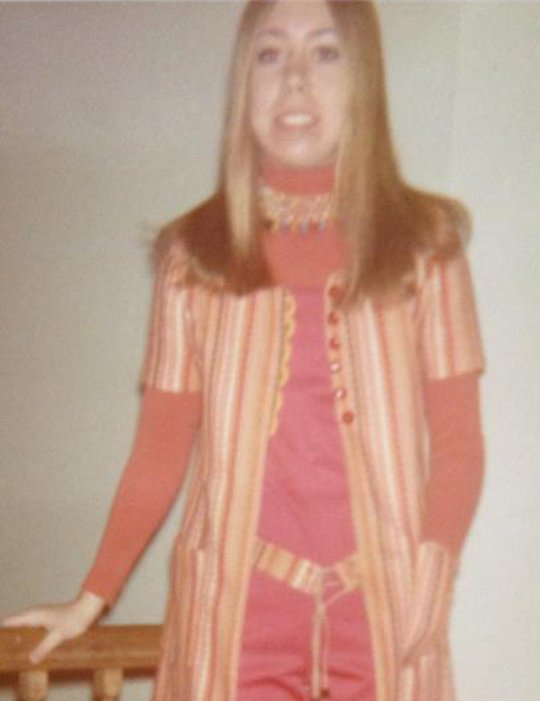
Thanks to Barbara.
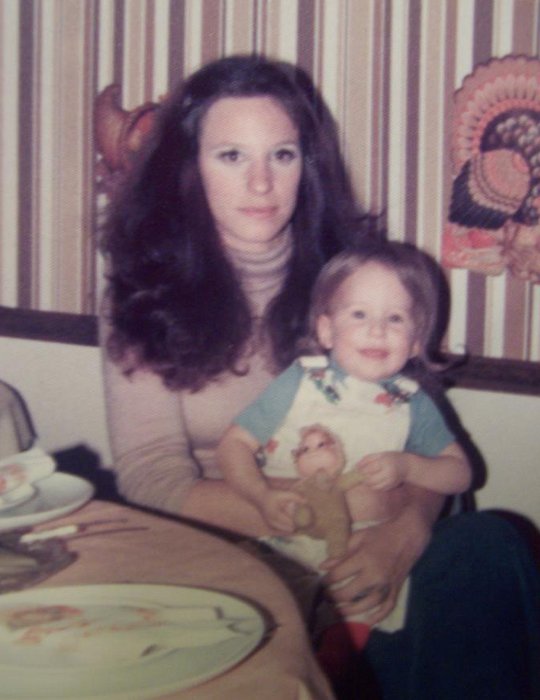
Thanks to Victory Vintage Boutique.

Thanks to Lotta.
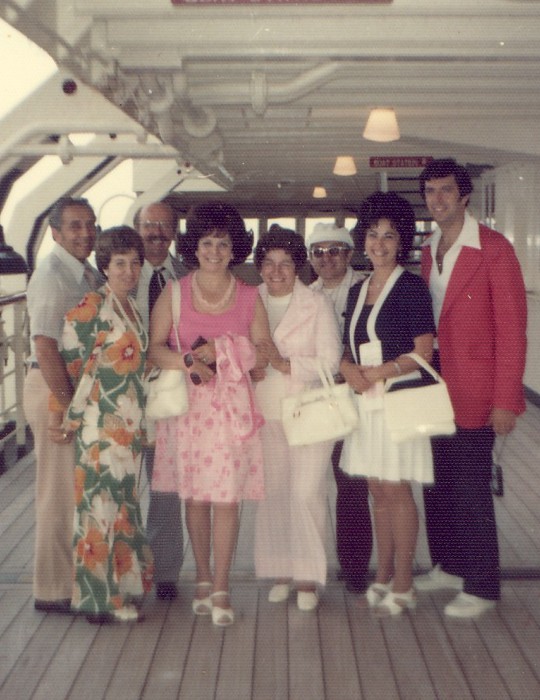
Thanks to Diane of Snapshot Fashion.
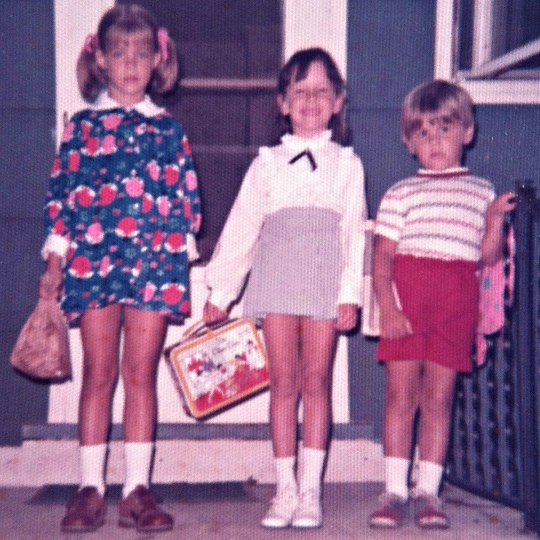
Thanks to Red Hanger Vintage.
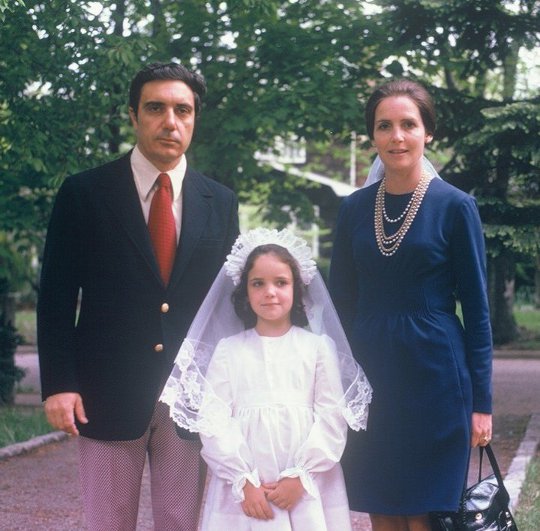
Thanks to Michele of Gollum Vintage.
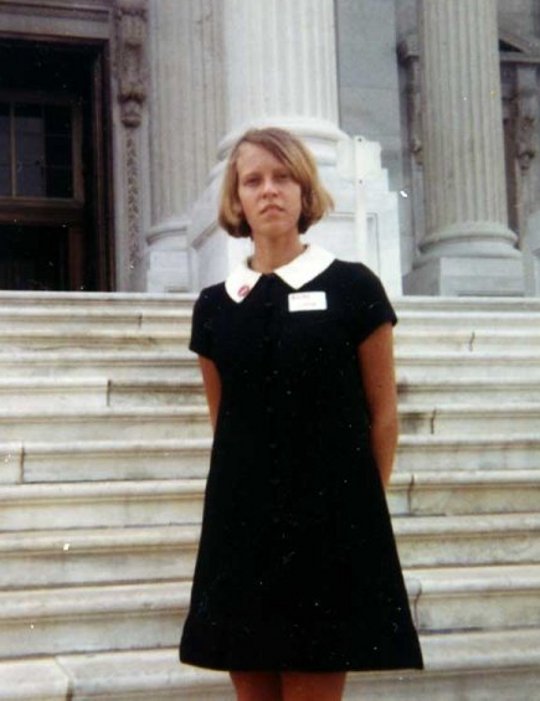
Thanks to Rebecca of Crea8tive Compass Magazine.
More 1970s Fashion Trends
CLOTHING: ’70s Clothing You Can Wear Today
DRESSES: 15 Ways You Can Wear 1970s Dresses
PHOTOSHOOT: ’70s Dresses as Modeled by Me from Olive’s Very Vintage
INFLUENCE: Why ’70s Fashion Icons Are Inspiring
HOW TO WEAR: A ’70s Maxi Dress and a ’70s Sleeveless Top
FROM OUR PARTNERS
’70s Fashion Ad Directory from 1970-1979 Thanks to Paperpast
’70s Fashion Beauties Who Inspire Thanks to I’m Obsessed with This
Hilarious ’70s Advertisements Thanks to Messy Nessy Chic

I love these posts! Fantastic information & photos.
Thanks so much Kira! XO
Ahhh amazing photographs! I’m so happy to see my parent’s photo on here! (My twin sister sent it in – Little Bird Vintage) :) Thanks so much for featuring them!
Hey Little Bird Vintage – thanks so much for sharing their photo with me. Can’t wait to see what others we gather up for future posts ;-) ’70s love!
What a good read! So interesting and the photos just bring it to life even more! ! I absolutely love the section on the punk rock movement.
The 70s punk rock counterculture spirit is still alive and well with a few new twists added in. Our new counterculture isn’t afraid to take 70s hippie, punk rock, Victorian style and a dash of new rainbow rave and mix it all together with the weight of the artistic and historical significance of the pieces adding depth to everyday wear.
The depth evident in your stunning article makes thrifting and finding a sort of archeology and the act of wearing the garments a bit more poetic then going about in an average department store outfit.
Or at least that is how I see it :-)
Thank you so much for the feature!
-laura
hi Laura! No, thank you for your commitment to vintage and giving attention to what you want to grow. You are very right about “archaeology.” I may steal that from you ;-)
Fabulous and informative!
To sum a decade in fashion and trends is no easy feat! This is a go-to article for anyone who wants to know about what the 70’s looked like. Highly recommended! I enjoyed the “real life” photos side by side with slicker more polished advertising photos. Thanks for the feature!
-Carla
All about the slick advertising photos ;-)
Thank you so much for this wonderful post and for choosing my orange leisure suit as an example! As always, Sammy, you are my go-to site for info and inspiration on vintage clothing!!! As I move my etsy shop from Elevations over to EchoFoxtrot, and try to improve my descriptions and photos, I continue to find the details I seek from your great work here! You really are an inspiration!!!
Emily, you had the best ’70s leisure suit on Etsy that I could find! Thanks so much for stopping by and spreading vintage love, and for doing what you do. XO